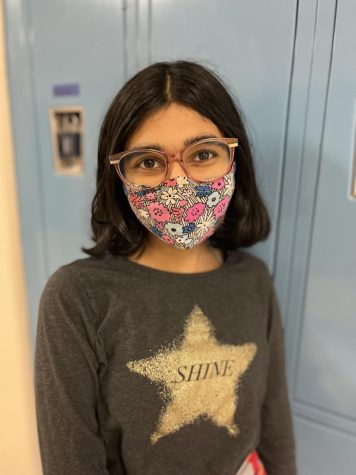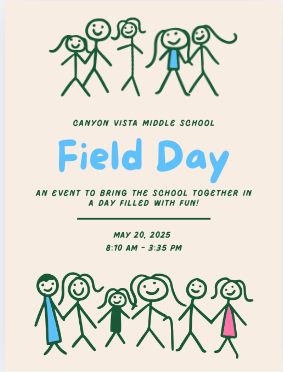The Impact of Beauty Standards in CVMS
“I think men are held to a lower standard than women are, but I still think, you know, look at the commercials on the TV – Get stronger, get buffer, get more hair, you know. Because that’s what everybody wants.” Mr. David Hampf, 8th grade US History and BIMM teacher said.
Beauty is in the eye of the beholder. To millions of teenagers across the country, this is the most blatant lie they’ve been told. Beauty is clicks, likes, and the opinion of a social clique that you will forget about mere months after you graduate and go separate ways. But from the age of 12-18, it’s everything. Meeting the standards that society decided were appropriate is all we think about. We try to meet the unrealistic beauty standards, when really, we should be questioning them. But it’s not that bad, right? It’s just clicks and likes, surely it can’t matter that much? However, statistics say otherwise.
According to the National Association of Anorexia Nervosa and Associated Disorders (ANAD), eating disorders are among the deadliest illnesses, and almost 28.8 million Americans will have one in their lifetime. Over 10,000 deaths each year are because of eating disorders. The list could go on. Beauty standards go far deeper than altering your body to fit beauty standards – it can be perilous to your health. About 81% of 10-year-olds are afraid of being fat. This problem starts young; A generation of children are being confronted with beauty standards and eating disorders while they are still hanging from the monkey bars on their school playground.
“I think there is a lot of self-doubt which is gonna be a problem during adolescence, but I think social media has heightened it, especially because of the way you can use filters and what not to make yourself appear perfect when of course we all know there’s no such thing. But it’s harder to reconcile that in your own appearance, and of course you’re constantly being barraged with images of what you’re supposed to think is beautiful, which is usually a pretty narrow standard.” Eighth grade ELA teacher Mrs. Kimberly Fritch said.
Social media has helped exacerbate eating disorders, and that’s not an opinion. Data from a study done by the Natural Library of Medicine confirms this. A study of 1765 randomly selected people from the ages of 19-32, showed that there is a strong and consistent association between social media use and eating concerns amongst young adults.
“I think that with students having so much access to social media, it’s really typical to disconnect what they’re seeing with reality. I think one of the things that students don’t see is always the digital retouching that occurs in social media and how angles and clothing make a difference in terms of pictures. What bothers me most is the standard of beauty for young women that we have as a society so that we feel like we have to look a certain way.” Eighth grade Science teacher Mrs. Melinda Schermerhorn said. “I think there are subtle things I notice about eighth graders. Certain students worry about their clothing, they worry about being accepted by others based on looks. [They’re] constantly pulling their phones out at times just to look at their hair, makeup, etc.”
But it’s not just teachers who share the concern that beauty standards are harmful for students’ futures; many students share the same concerns.
“So like, cause, the beauty standard, everyone wants to follow, and I see a lot of people not eating lunch, and just commenting about their appearances all the time. And it’s like, you can’t change stuff about your face, like, if you want a slimmer nose, you can’t just naturally get a slimmer nose, so why would you comment on it anyways?” Emily Xue (8) said.
However, there also is a difference between beauty and makeup, as well as cultural norms dictating if a person can or cannot wear makeup.
“It can harm a person’s mental health. Beauty standards affect how you treat other people a lot. The fact that people make money off of it, the fact that so many companies profit off of women’s insecurities, and make it seem like they’re empowering themselves, making it seem like ‘Oh actually I’m doing this for myself’ – That entire idea of wearing makeup for yourself has been ruined, because where do you draw the line between ‘Am I doing it for myself?’ or ‘Am I doing it for beauty?’” Deetyaa Shah (8) said.
Teenagers across the world and at Canyon Vista struggle with this issue, and both students and teachers have recognized it. Students have realized that their own peers are struggling with an issue that could alter the course of their lives. Beauty standards seem like an arbitrary metric developed by society when in reality, they have the potential to harm. From things such as skipping meals to serious mental health issues, we need to do more to address the problems that beauty standards cause.

Hi. I love writing, and this is my second year writing for Canyon Echoes. I am Editor in Chief, and I'm really excited to work with Saanvi and Vedanti,...

Hey, I'm Vedanti, and I'm in 8th grade! I'm really excited to lead Canyon Echoes alongside Nikhil and Saanvi. In my free time, you can find me reading,...




















